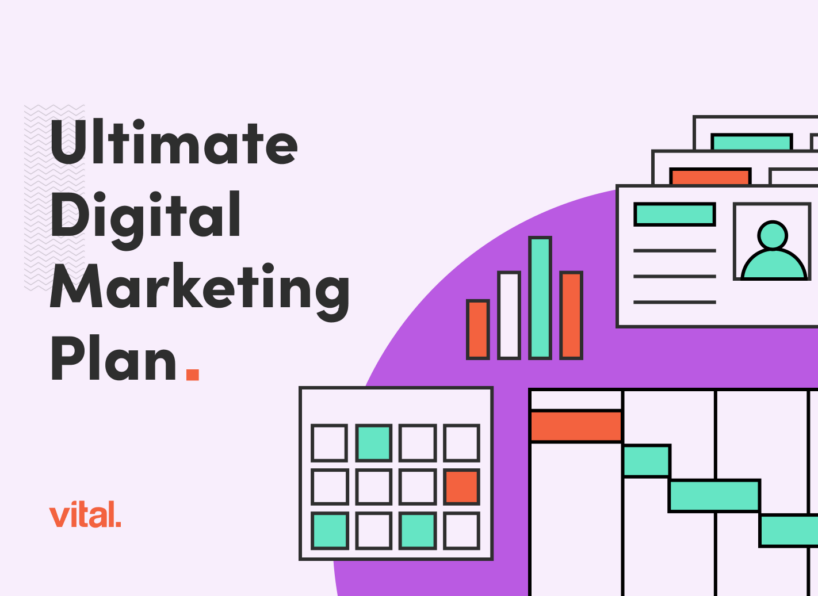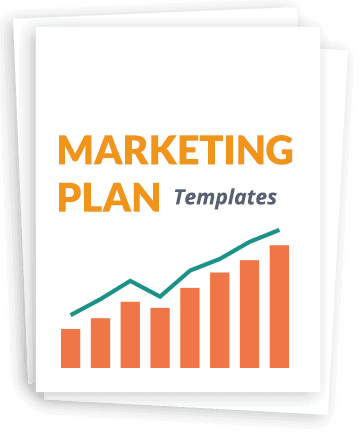Picture this: You own or work at a successful company, one that’s looking to increase its customer base and expand in the next few years. To achieve these goals, you’ll need to generate more leads, which means you need a marketing strategy that will impress stakeholders, secure internal buy-in, and — most importantly — drive measurable success.
Creating such a strategy is easier said than done. You may struggle with questions such as “How do we set a budget and allocate it effectively?,” “Where should we spend our time and money?,” or “Where do we even begin?”
A digital marketing plan can answer them all.
Attempting to promote your brand and generate new business without a digital marketing plan is like setting sail without a compass or map; you have a destination in mind, but no sense of direction or way of knowing how to get there. A digital marketing plan will prevent you from going off course and steer your brand toward key objectives, such as lead generation, revenue growth, and new customer acquisition.
In this comprehensive guide, we’ll cover the essential components of an effective digital marketing plan, with real-world examples and a downloadable template, so you can navigate the digital landscape with precision and purpose.
Just want the marketing plan template? Get it here >
What Is a Digital Marketing Plan?
It seems as though every marketing agency and department has a slightly different idea of what constitutes a digital marketing plan, but they all have one thing in common: Digital marketing plans outline all of a company’s strategic initiatives in support of a stated goal, with actionable next steps to work toward that goal.
Compared to traditional marketing plans, which focus on offline channels such as television, radio, and print ads, digital marketing plans leverage online channels, such as email marketing, pay-per-click advertising, and content marketing, to reach your target audience. These plans can take many formats, from traditional, text-based documents or slide presentations, to spreadsheets or Gantt charts. The individual scope, focus, and structure of your digital marketing plan will vary depending on what you aim to achieve. (More on that later)
The Benefits of a Well-Structured Digital Marketing Plan
If you’re unsure whether your company needs or would benefit from a digital marketing plan, ask yourself the following:
- Do we have a clear idea of who our target audience is, and how best to reach them? While having a generalized digital marketing strategy is better than having no strategy at all, it won’t help you reach the right people. Digital marketing plans include content and campaigns designed to speak to specific personas, increasing your likelihood of connecting with prospective customers in a meaningful way.
- How well do we understand our customers’ journey? A digital marketing plan will ensure that you have the right content that delivers the right message at every stage of the customer journey, converting traffic into leads and nurturing prospects through the sales funnel.
- Are our goals quantifiable? You can’t manage what you don’t measure. A digital marketing plan will define specific, measurable, achievable, relevant, and time-bound (SMART) goals you can use to gauge the progress and success of your campaigns and to determine which messaging is most effective.
- How consistent is our brand messaging across different channels? A digital marketing plan can help you create a messaging framework, so that your audience receives the same message about why your brand is right for them across every channel. And brand messaging is proven to outperform performance messaging 80% of the time, showing that, when paired with a strong brand identity, consistency really is key.
- How effectively are we allocating our existing resources? A digital marketing plan offers clear guidance on how to allocate your budget, personnel, and technology according to the most critical marketing activities, ensuring you get the greatest return on your investments.
- Do we know how our competitors are utilizing digital channels? Competitor analysis is a foundational component of any digital marketing plan and can help you determine which strategies to emulate, as well as identify gaps in coverage and areas of opportunity.
Just want the marketing plan template? Get it here >
Creating a Solid Foundation for Your Digital Marketing Plan
Every house needs a solid foundation to provide structural support and stability. The same is true for a digital marketing plan — though, in this case, your foundation will consist of key metrics, buyer personas, and other documentation rather than a cement slab.
Before you begin building your digital marketing plan, make sure you have the following:
Business Overview
It likely goes without saying, but to effectively market your business and its products or services, you need to have a clear understanding of what those actually are. This should go beyond just a basic definition and instead capture valuable information about your brand identity, industry standing, value proposition, and competitive positioning. It should also include details about your primary products or services, including who they’re for, how they function, what purpose they serve, and what value they offer.
Unique Selling Proposition
Your unique selling proposition (USP) should explain what sets your company and its offerings apart from the competition — essentially, why customers should choose you over your competitors. When creating your brand’s USP, ask yourself the following:
- What do our customers want that only we can provide?
- What do we do better than our competitors?
- What is the most significant benefit our customers achieve from choosing our company over our competitors?
Market Analysis
Every market is unique, with different dynamics at play that will impact how you promote your company and its offerings. Market analysis provides a structured framework for evaluating these internal and external factors and determining how best to respond to them. A SWOT analysis — short for strengths, weaknesses, opportunities, and threats — is the most common form of market analysis, intended to help businesses identify where they excel, where they fall short, and what they need to watch out for. A SWOT analysis can provide valuable insight into where your company stands within the market, enabling you to pursue opportunities and mitigate potential threats.
Competitor Analysis
Sometimes our biggest opponents can be our greatest teachers — at least, that’s part of the idea behind competitor analysis. Closely related to market analysis, this form of analysis involves taking a closer look at your competitors’ digital presence to assess their strengths and weaknesses, identify industry trends, and benchmark your own performance. Most importantly, competitor analysis enables you to locate niches in the market that your competitors have yet to carve out. This enables you to create content that strategically differentiates your brand.
Business Goals
Whether you aim to improve your digital presence and increase brand awareness or to expand into new markets and capture new revenue streams, it’s essential that you define overarching business goals that will drive your digital marketing strategy. These broad, long-term objectives will filter down into your digital marketing plan, helping your marketing team define more focused, time-bound objectives specific to individual projects or initiatives.
Download your marketing plan template here >
Target Audience
Your target audience is a strategically defined group of individuals who share common characteristics — such as demographics, behaviors, or interests — and represent the primary focus of your business’s marketing efforts. Knowing your target audience will enable you to tailor your content strategy to speak to prospective customers’ needs, preferences, and pain points.
To define your target audience, you’ll need to conduct market and demographic research, analyze customer data and behavioral patterns, and interview actual customers. Similar to goals and objectives, it’s important to start broad and gradually narrow your focus.
For example, a higher education institution’s target audience might be prospective graduate students. The university could then build out individual buyer personas that exist within that broader audience, such as students seeking professional advancement, students interested in graduate-level research, and students looking to change careers. These more targeted, micro-audiences will influence how you structure your digital marketing plan, including what projects to prioritize.
Channels
Digital marketing channels refer to the various avenues through which you’ll promote your business and engage with your target audience. At minimum, these should include:
- Website: Statista reports that 65.7% of the global population uses the internet — and many of these users rely on it as their primary source of information. Having a well-designed website is now table stakes, with organizations across all industries using their websites to establish an online presence, showcase their products and services, and engage with their audience.Your website will also provide a necessary foundation for other digital marketing efforts, creating a centralized hub for search engine-optimized content and supporting conversion rate optimization (CRO) through the use of A/B testing, responsive layouts, fast loading times, effective calls-to-action, and more.
See How the University of San Diego’s New Website Sets the Stage for Student Journeys >>
- Content Marketing: Well-written, well-researched, and informative content is the cornerstone of any successful digital marketing strategy. From blog posts, eBooks, and case studies to infographics, videos, and white papers, marketing collateral can take many forms, but it all has a shared purpose: to educate your audience and elevate your brand by positioning you as a thought leader within your industry.The more in-depth and informative your content, the better, as Google’s quality rater guidelines take experience, expertise, authority, and trustworthiness (E-E-A-T) into account when ranking content. But E-E-A-T is only half of the equation. For your content to rank, it has to be optimized for search engines — which brings us to…
- Search Engine Optimization: Search engine optimization (SEO) enhances the various elements of your website — both on- and off-site — that search engines consider when determining the relevance and authority of a page. It includes techniques such as keyword optimization, meta information, link building, user experience optimization, and, most importantly, high-quality content marketing — all of which can improve your website’s ranking and increase organic (unpaid) traffic.
Turn Your Website into a Lead-Generation Machine with These Best Practices >>
- Email Marketing: A form of content marketing, email marketing involves sending personalized messages to your target audience, or even a specific segment of your target audience, to maintain relationships, promote offerings, and drive engagement and conversions.There are many different types of email marketing campaigns, each designed to serve a unique purpose. For example, transactional emails are triggered by a user action, such as signing up for a service or filling out a form; lead nurture campaigns (LNCs) deliver relevant, personalized content in an effort to nurture leads through the sales funnel; re-engagement emails attempt to revive interest and encourage recipients to interact with your brand again; and so on.Which email marketing campaigns you run will depend entirely on what you aim to achieve and which segment of your audience you’re targeting.
- Paid Media: Paid digital media is the counterpart of SEO, focusing on increasing traffic to your website through paid ads rather than organically. One of the most common forms of paid digital media is paid search. With paid search campaigns, you bid on specific keywords relevant to your target audience. When users conduct searches containing those keywords, the ads appear at the top or bottom of the search engine results page (SERP). You then pay a fee any time a user clicks one of your ads, which is why paid search is also known as pay-per-click (PPC). Paid digital media extends beyond search engines and can include paid advertising on other online platforms, such as social media networks. PPC’s appeal lies in its immediate impact — since you only pay when a user clicks on your ad, it’s a measurable, cost-effective means of driving targeted traffic to your website.
- Social Media Marketing: The number of social media users is projected to reach almost 6 billion by 2027, making this a prime channel for digital marketing. Social media marketing encompasses a range of activities, from placing paid ads and sharing new content to promoting events and interacting directly with your audience. Social media marketing is an effective way for businesses to raise brand awareness and increase engagement, which ultimately drives leads.
Tools
Before you can begin developing your digital marketing plan, you need to know which tools are in your tech stack and what your automation capabilities are.
Whether it’s your content management system (CMS), your marketing platform, or your web analytics service, each solution has its strengths and limitations; understanding these can help you leverage them effectively. It’s also essential that the tools within your tech stack be tightly integrated, so that data can seamlessly flow between systems, allowing for data consistency, efficient workflows, and accurate reporting. Automation further enhances efficiency by eliminating manual effort, enabling your team to focus on more strategic, value-adding tasks.
It’s worth noting that understanding your tech stack and automation capabilities isn’t just about using your existing resources more effectively. It’s also about identifying any gaps in coverage or capability that you’ll need to resolve by implementing new technology.
Download your marketing plan template here >
Budget
When we talk about setting a budget during the foundational stage, we’re specifically referring to your overarching marketing budget. In other words, how much can your company realistically afford to spend on all marketing activities? Having a specific figure in mind will help you balance resource allocation across all marketing channels and initiatives, creating a framework for your team to strategically prioritize work and distribute funding with the goal of maximizing impact and ROI.
Staffing Resources
Every digital marketing plan requires a team of skilled professionals to execute it. Before you get started, determine whether you have the in-house expertise and the available capacity to develop and manage your plan or if you’ll require third-party support.
Reporting & Analytics
Last, though certainly not least, you need to know where your company currently stands relative to where you want it to be. Pulling reports and reviewing metrics during the foundational stage will help you establish a baseline against which you can measure the success of any projects included in your digital marketing plan.
What’s in a Digital Marketing Plan?
Market analysis? Check. Target audience? Check. Budget and existing resources? Check and check. Now that you have your foundation firmly in place, you’re ready to start creating your digital marketing plan — and we’ve put together a list of exactly what you’ll need.
To make things easy, we recommend that you download our digital marketing plan template and follow along as you read through our list of key components:
- Business Summary: This should include the business overview and USP you drafted during the foundational stage, as well as a roster of the members of your marketing team.
- Executive Summary: Your executive summary should concisely explain where your company currently stands, what you aim to achieve, and the role digital marketing will play in achieving your goals.
- Market Summary: Your market summary should be a report on the findings of the market analysis you conducted during the foundational process. It should include the results of your SWOT analysis, as well as summarize market trends, forces, and forecasts.
- Competitor Summary: Your competitor summary should be a report on the findings of your competitor analysis. For each major competitor you include in this summary, list their strengths, weaknesses, core message, value proposition, and how your company differs from or outperforms them.
- Customer Summary: This is where you include any pertinent information about your target audience, with a few key details about the different buyer personas that exist within it, including the specific problem or challenge they face, what questions they might have, and why they might choose your brand.
- Buyer Personas: This is where you’ll include the actual buyer personas you created during the foundational process. Each persona should include demographic information, what that individual wants, how they find information, what their goals are, common questions, their specific pain points, and how your company can help them.
- Marketing Goals: This is the part where, using your company’s overarching business goals as a point of reference, you define marketing-specific goals. For example, if your overarching goal were to increase your company’s market share by 15% over the next fiscal year, your marketing goals might be to gain a certain number of new customers, either in general or in a specific industry or segment. These marketing goals will inform your digital marketing strategy — that is, the various marketing initiatives you’ll use to achieve those goals.
- Marketing Channels: This section of your digital marketing plan will list out the various channels you intend to use to reach your customers, with details about what goals you hope to achieve with each channel, and how you intend to measure your success.
- Marketing Initiatives: Your marketing initiatives are the projects you’ll focus on to achieve your company’s marketing goals. You might use a combination of search engine-optimized thought leadership articles, on-demand video content, a monthly newsletter, and paid digital ads to raise brand awareness and capture new audience segments. When scoping out marketing initiatives, be sure to keep your intended audience in mind, as well as what stage of customer journey and sales funnel they’re in.For each initiative you intend to work on, clearly define the following:
- What the deliverable will be
- What your SMART goals are (e.g. gain 1,000 visitors per month on a specific piece of content)
- Key performance indicators to monitor (e.g. for a blog post, these might include pageviews, unique visitors, conversion rates, and of leads generated)
- What steps you need to take to complete the initiative (e.g. conduct keyword and competitor research; write copy; design graphics; publish; promote through emails, social media, and/or PPC)
- Budget Breakdown: You established an overall marketing budget during the foundational stage; now, you’ll need to allocate that budget strategically across your various marketing activities and initiatives. This section of your digital marketing plan should include a projected monthly budget for each of your proposed initiatives.
- Marketing Calendar: To keep your digital marketing plan on track, we recommend planning out your marketing initiatives on a quarterly basis. When creating your marketing calendar, be sure to separate projects out by type, include the status of each project, link out to any related documentation, and list out what resources (personnel, budget, tools) you’ll need to support that project.
- Key Performance Indicators: Be sure to define KPIs for all of your marketing channels, as well as individual initiatives; these will serve as the foundation for monthly reporting and data analytics. For recommendations on which marketing KPIs to track, check out this free, downloadable resource.
Pull the Right Digital Marketing Lever
Even with a roadmap to follow, figuring out where to channel your focus and what to include in your digital marketing plan is easier said than done. At Vital, we like to contextualize things for our clients by describing different digital marketing plans as “levers” they can pull depending on their needs and goals.
- Lever 1: Your goal is to increase the size of your sales funnel by driving more traffic to your website. To achieve this, consider targeting high-traffic channels, such as SEO, organic social media, email, paid media, and paid social media.
- Lever 2: You have a steady stream of traffic to your website, but you need to convert it at higher rates, turning traffic into leads, leads into prospects, and prospects into opportunities. To increase conversions, try adding early-stage conversion offers, such as eBooks, white papers, checklists, and guides, and adding early-to-mid-funnel offerings, such as webinars, case studies, and pre-recorded demos.You should also implement conversion rate optimization (CRO), such as A/B testing, exit overlays, and banners. You can even adjust your conversion offerings, page content, page layouts, and overall design to maximize conversion rates.
- Lever 3: You’re successfully converting website traffic into leads, prospects, and opportunities but need to take the next step and turn opportunities into customers. To move people through the sales funnel at a more efficient rate, start by updating your marketing automation tools, as well as your LNCs and sales team or business development representative process.This is also a great time to add more structure and content to your email marketing strategy — focus on content that helps build trust with your audience and demonstrates your company’s value, such as case studies, ROI analysis, and testimonials.
- Lever 4: Your digital marketing strategy is perfectly designed to move people through your sales funnel — now, you just need to raise brand awareness and generate demand. To do so, focus on driving traffic to your website through various channels. Thought leadership content, such as social media posts, webinars, guest posts, special events, and conference presentations, is especially valuable at this stage because it establishes your organization as an authority in your industry.You should also leverage broad paid advertising strategies to maximize your brand exposure. Targeting social channels, display channels, video channels, and even sponsorships are all potential ways to build brand awareness.
Ideally, these levers should follow one after the other, creating a logical path for you to follow when creating your digital marketing plan.
Not sure which lever you need to pull? We can help with that — just send us a message to start the conversation.
Digital Marketing Plan Examples
Here at Vital, when we start working with a new client on the digital marketing side of our business, we start with multi-week foundational process that consists of the following:
- A foundational questionnaire to assess the client’s target buyers, messaging, and competitive landscape
- An admin and tools questionnaire to provide background information on all of the client’s marketing tools
- Competitor research and market analysis, which we compile into a slide deck for our paid media, SEO, and content marketing teams
- A kickoff meeting, during which we introduce members of our team, explain how our digital marketing program works, and try to learn as much about the client’s business, goals, industry, previous successes and failures as possible.
- Sales team (or enrollment team) interviews, which we use to learn about common obstacles the client’s sales team faces and determine what messaging resonates with their target audience
- Customer interviews, which we use as the basis for the client’s buyer personas
- A style guide, which documents the client’s brand voice and tone, stylistic preferences, and key details about their company, products, and services
- A foundational calendar, which we use to scope out early projects with time estimates
We use all this information to create a solid foundation on which to build the client’s digital marketing plan.
Download Your Digital Marketing Plan Template
Ready to create your own digital marketing plan? Let us save you some work! We’ve created this comprehensive template — including all of the components listed above — so you can spend less time planning and more time executing a winning digital marketing strategy.
No need to reinvent the wheel — simply download your copy and edit as needed.





